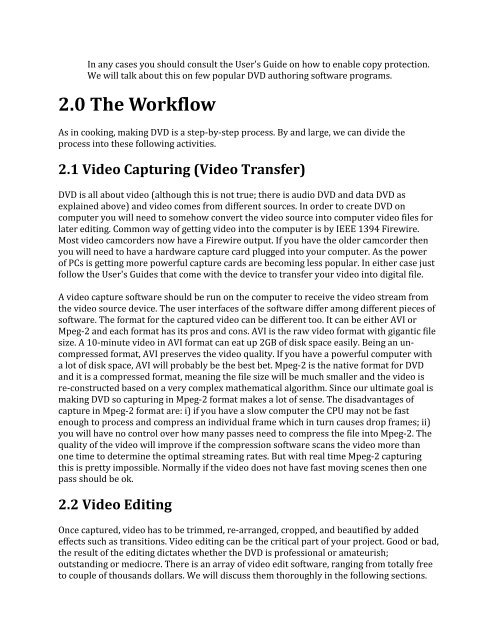Making Professional DVD from Authoring to ... - CD Duplication
Making Professional DVD from Authoring to ... - CD Duplication
Making Professional DVD from Authoring to ... - CD Duplication
You also want an ePaper? Increase the reach of your titles
YUMPU automatically turns print PDFs into web optimized ePapers that Google loves.
In any cases you should consult the User's Guide on how <strong>to</strong> enable copy protection.<br />
We will talk about this on few popular <strong>DVD</strong> authoring software programs.<br />
2.0 The Workflow<br />
As in cooking, making <strong>DVD</strong> is a step-by-step process. By and large, we can divide the<br />
process in<strong>to</strong> these following activities.<br />
2.1 Video Capturing (Video Transfer)<br />
<strong>DVD</strong> is all about video (although this is not true; there is audio <strong>DVD</strong> and data <strong>DVD</strong> as<br />
explained above) and video comes <strong>from</strong> different sources. In order <strong>to</strong> create <strong>DVD</strong> on<br />
computer you will need <strong>to</strong> somehow convert the video source in<strong>to</strong> computer video files for<br />
later editing. Common way of getting video in<strong>to</strong> the computer is by IEEE 1394 Firewire.<br />
Most video camcorders now have a Firewire output. If you have the older camcorder then<br />
you will need <strong>to</strong> have a hardware capture card plugged in<strong>to</strong> your computer. As the power<br />
of PCs is getting more powerful capture cards are becoming less popular. In either case just<br />
follow the User's Guides that come with the device <strong>to</strong> transfer your video in<strong>to</strong> digital file.<br />
A video capture software should be run on the computer <strong>to</strong> receive the video stream <strong>from</strong><br />
the video source device. The user interfaces of the software differ among different pieces of<br />
software. The format for the captured video can be different <strong>to</strong>o. It can be either AVI or<br />
Mpeg-2 and each format has its pros and cons. AVI is the raw video format with gigantic file<br />
size. A 10-minute video in AVI format can eat up 2GB of disk space easily. Being an uncompressed<br />
format, AVI preserves the video quality. If you have a powerful computer with<br />
a lot of disk space, AVI will probably be the best bet. Mpeg-2 is the native format for <strong>DVD</strong><br />
and it is a compressed format, meaning the file size will be much smaller and the video is<br />
re-constructed based on a very complex mathematical algorithm. Since our ultimate goal is<br />
making <strong>DVD</strong> so capturing in Mpeg-2 format makes a lot of sense. The disadvantages of<br />
capture in Mpeg-2 format are: i) if you have a slow computer the CPU may not be fast<br />
enough <strong>to</strong> process and compress an individual frame which in turn causes drop frames; ii)<br />
you will have no control over how many passes need <strong>to</strong> compress the file in<strong>to</strong> Mpeg-2. The<br />
quality of the video will improve if the compression software scans the video more than<br />
one time <strong>to</strong> determine the optimal streaming rates. But with real time Mpeg-2 capturing<br />
this is pretty impossible. Normally if the video does not have fast moving scenes then one<br />
pass should be ok.<br />
2.2 Video Editing<br />
Once captured, video has <strong>to</strong> be trimmed, re-arranged, cropped, and beautified by added<br />
effects such as transitions. Video editing can be the critical part of your project. Good or bad,<br />
the result of the editing dictates whether the <strong>DVD</strong> is professional or amateurish;<br />
outstanding or mediocre. There is an array of video edit software, ranging <strong>from</strong> <strong>to</strong>tally free<br />
<strong>to</strong> couple of thousands dollars. We will discuss them thoroughly in the following sections.


